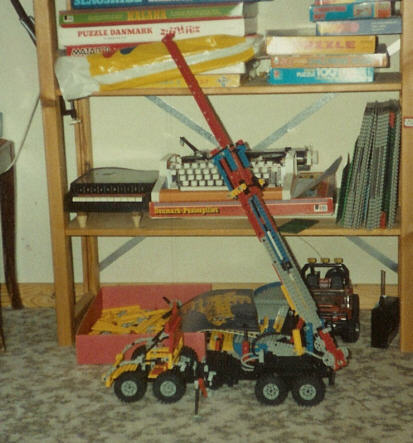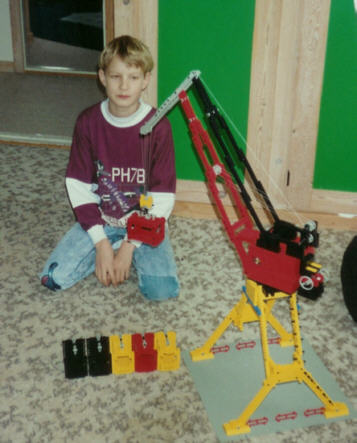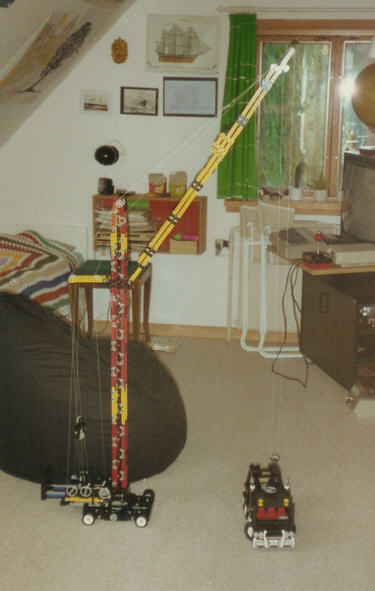History
Christmas Eve 1986, I got my first LEGO Technic set, here my interest for LEGO changed a bit, before that I
consentrated me about building cities, houses, small cars etc. but now I had a more technical interest for working
constructions, and recreate them in LEGO.
After a couple of years my collection has grown, at it is now possible for me to build larger constructions.
Every LEGO Technic constructor with a little selfrespect have tried to construct a crane in his/her carrier, including me.
My first Mobile Crane

Of course I also tried to build a mobile crane, and the first real attemp to solve the problem can bee seen on the
picture to the right. I remember my father helped me with some parts of the crane, since he knew a lot more about cranes and
technic than me, so he was able to give me good advises and facts from the real cranes.
The crane was not attemped to look like a certain mobile crane, only the functionallity was important. It is constructed
with 4 axles, the 2 in the rear is driven by differential from a 1 cylindered engine. The 2 in the front can be
steared in different angles throug different gears.
In the middle of the cranes, there are 2 outriggers to support the crane, they are manually driven.
The main boom is equipped with a single telescopic section, operated by wires. Raising the main boom, is
pneumatic, by the old singleoperated cyliders.
Other cranes
Through the years, I have constructed a lot of different models, but they are mostly around the same type,
either vehicles or cranes. My interest for vehicles is probably because of my father who have been a truck and
coach driver for many years, I have spend a lot of time together with him on the roads.
For some years I had the opportunity to ride with my father to Rostock in Germany. In Rostock which is a large harbour,
 you can find a lot of interesting machinery to study, specially a lot of huge cranes for loading and undloading
the ships and trucks. My next LEGO construction is from that time, and the result is seen on the picture to the left.
The crane is built on a huge LEGO plate to get the required support. The turntable is constructed the same way as
the turntable in the excavator 8851.
Hoist and booms are controlled manually by wires and winch in the rear of the cranes. One of the main advantages with
this type of crane, and the difficult part to build, is to get the tip of the boom to move horisontally in and out,
when the main boom is raised and lowered. It almost succeded, and I used a lot of time loading and undloading small
trucks and ships with containers.
you can find a lot of interesting machinery to study, specially a lot of huge cranes for loading and undloading
the ships and trucks. My next LEGO construction is from that time, and the result is seen on the picture to the left.
The crane is built on a huge LEGO plate to get the required support. The turntable is constructed the same way as
the turntable in the excavator 8851.
Hoist and booms are controlled manually by wires and winch in the rear of the cranes. One of the main advantages with
this type of crane, and the difficult part to build, is to get the tip of the boom to move horisontally in and out,
when the main boom is raised and lowered. It almost succeded, and I used a lot of time loading and undloading small
trucks and ships with containers.
Another interesting type of cranes, is the crane you can always find on every construction site, tower cranes. If those
cranes wasn't invented, it is hard to know how long time it would take to build buildings today. The tower crane handles
all kind of materials around the contruction site, and keep every man busy, no matter if he is down a hole, or on top
of a building. This cranes has also caught my interest and I have constructed a tower cranes from a little SIKU
model my parents gave me some years ago.
 The crane is constructed so the main boom can be folded and the tower lowered to the front by wires, whinces and counterweights.
When the crane is packed, it can be put on a 3 axle tractor. In this way it is possible to move the crane from one place
to another in a very short time. To handle a given load, the crane is equipped with a movable counterweight in the buttom.
The crane is constructed so the main boom can be folded and the tower lowered to the front by wires, whinces and counterweights.
When the crane is packed, it can be put on a 3 axle tractor. In this way it is possible to move the crane from one place
to another in a very short time. To handle a given load, the crane is equipped with a movable counterweight in the buttom.
Since the digital camera wasn't invented when I was a little boy, I haven't got that many pictures of my old
constructions through the years. Its a bit annoying, because it is quite fun to remember old times, and all the fun
and hours you have spend with the LEGO.
Regrettably there are more and more things in the all day, which take up time, so it is not that often there are
an opportunity to construct something in LEGO. But if the opportunity is there, I love to take a little brake from the stressfull everyday life...
 you can find a lot of interesting machinery to study, specially a lot of huge cranes for loading and undloading
the ships and trucks. My next LEGO construction is from that time, and the result is seen on the picture to the left.
The crane is built on a huge LEGO plate to get the required support. The turntable is constructed the same way as
the turntable in the excavator 8851.
Hoist and booms are controlled manually by wires and winch in the rear of the cranes. One of the main advantages with
this type of crane, and the difficult part to build, is to get the tip of the boom to move horisontally in and out,
when the main boom is raised and lowered. It almost succeded, and I used a lot of time loading and undloading small
trucks and ships with containers.
you can find a lot of interesting machinery to study, specially a lot of huge cranes for loading and undloading
the ships and trucks. My next LEGO construction is from that time, and the result is seen on the picture to the left.
The crane is built on a huge LEGO plate to get the required support. The turntable is constructed the same way as
the turntable in the excavator 8851.
Hoist and booms are controlled manually by wires and winch in the rear of the cranes. One of the main advantages with
this type of crane, and the difficult part to build, is to get the tip of the boom to move horisontally in and out,
when the main boom is raised and lowered. It almost succeded, and I used a lot of time loading and undloading small
trucks and ships with containers.

 The crane is constructed so the main boom can be folded and the tower lowered to the front by wires, whinces and counterweights.
When the crane is packed, it can be put on a 3 axle tractor. In this way it is possible to move the crane from one place
to another in a very short time. To handle a given load, the crane is equipped with a movable counterweight in the buttom.
The crane is constructed so the main boom can be folded and the tower lowered to the front by wires, whinces and counterweights.
When the crane is packed, it can be put on a 3 axle tractor. In this way it is possible to move the crane from one place
to another in a very short time. To handle a given load, the crane is equipped with a movable counterweight in the buttom.